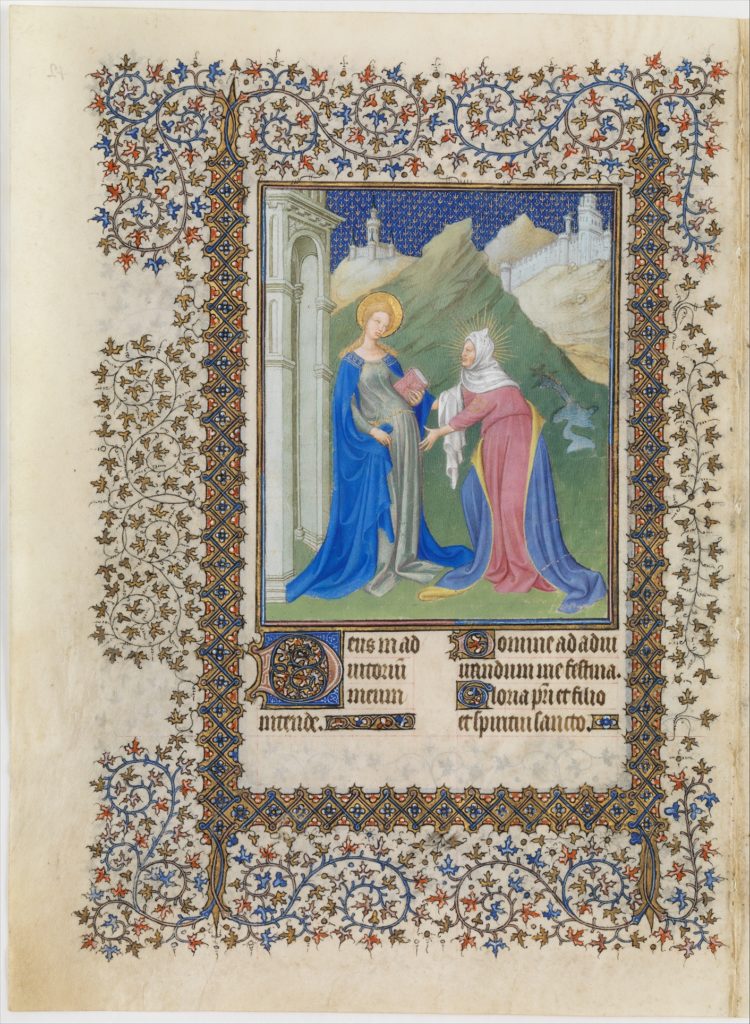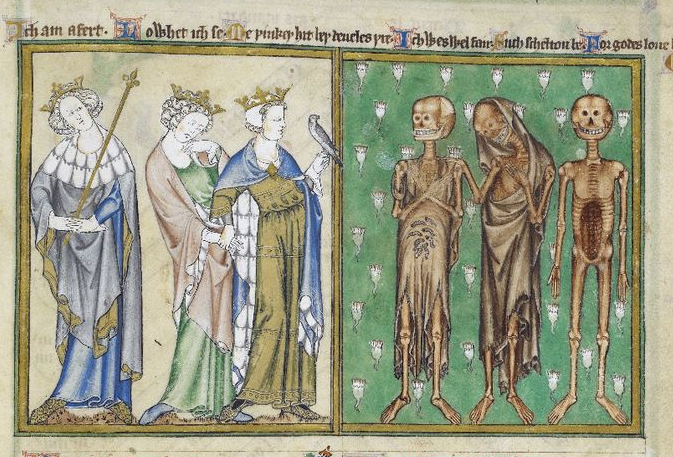Summary
Em and Jesse retell the story of Passover, and then discuss the story of the crucifixion in the New Testament and how the two dovetail. In the process, they cover Medieval traditions surrounding Easter week in a wide-ranging discussion that also touches on Gilgamesh, the harrowing of hell, and Peeps.
Citations, Annotations, and Corrections
1/ While listening back to this, I had a moment where I realized how many new varieties of yogurt are available now than were available when I was in college. For those unfamiliar, the forbidden Passover grains are wheat, barley, rye, oats, and spelt, and “kitniyot,” which means “legumes,” but in Ashkenazi tradition is a category that includes rice, corn , soybeans, lentils, and products derived from them. For weird historic reasons, potatoes are okay. (Also the key to really surviving while keeping kosher for Passover if you’re vegetarian is to keep Sephardic Kosher. Or eat a lot of sad potatoes.)
2/ Rivers are powerful symbols of purification and cleansing, travel and liberation, and boundaries. The Israelites had to cross the Red Sea to reach freedom, but the Biblical (New Testament) importance of the River Jordan–where John the Baptist baptized Jesus–becomes synchronous with the idea of freedom in the USA, where rivers formed boundaries between Slave states and Free states. While the Mississippi looms largest in the mythological psyche of the USA, the most famous crossing in American literature is probably Eliza’s escape across the frozen Ohio River in Uncle Tom’s Cabin. No artistic statement on the subject is greater than Alvin Ailey’s, seen here in a clip of the second movement (“Take Me to the Water”) from Revelations. –JN
3/ Yul Brynner: Hotter than a slave owner. But also–the guy was from Vladivostok, but played, among others, a pharaoh and a Thai king. C.f. “The Romans in Films” from Mythologies by Roland Barthes (Editions du Seuil, 1952; trans. by Annette Lavers, Paladin, 1972) . (I realize that this is a podcast about Medieval history and not a chance to critique films that came out in 1956. But all of this is to say–Ramses didn’t look like Brynner, and Moses didn’t look like Charlton Heston. That is Hollywood whitewashing.–Em)
4/ [7:30] “…People who are trying to derive that the Earth began on October 15th, 5032 BC…” Actually, October 23, 4004 BCE. Em was slightly off.
5/ The whole discussion of “the Egyptians built the pyramids” reminds me of the short story “Tower of Babylon” by Ted Chiang (in Story of Your Life and Others, Tor, 2002) . [Nat Geo article on the so-called “workers’ villages.”–JN]
6/ Suzan-Lori Parks, who is an amazing playwright, does “Watch Me Work”. This is a public art piece, but also an opportunity to carve out time for writing. Since we taped the episode, I’ve done one, and it was pretty cool. She works for 20 min (and so does everyone else), and then she answers questions from the audience for 40 minutes. [SLP is the BEST.–JN]
7/ I should clarify: Moses is allowed to lead the Israelites to the promised land, and he is technically allowed to see the promised land (which he famously does from the top of Mount Nebo before dying), but he’s not allowed in. In War for the Planet of the Apes (2017), Caesar similarly leads the apes to the promised land and dies within sight of it.–JN
8/ Transubstantiation: the conversion of the substance of the Eucharist (bread and wine) into the body and blood of Christ during communion. Consubstantial (the word I am trying to remember): of the same substance or essence, often used with the trinity (e.g., Christ is consubstantial with God the Father). As I allude to, a significant amount of my knowledge about Catholicism comes from reading Ulysses (and other books–Paradise Lost, Inferno, The Master and Margarita, etc.). –Em
9/ Triduum: From the evening on Holy Thursday until the evening of Easter Sunday. It sounds like I’m saying it to myself as “tri-deum,” which is–not right.–Em
10/ Palmesel donkey. Here is one in the collection at the Met from the fifteenth century. It weighs 182 lbs and is 62 inches tall, making it basically life-size.
11/ Palms symbolized victory. Palm branches were thrown before Jesus on his triumphant return to Jerusalem to signify his (future) victory–i.e., Jesus’s return is being compared to the triumphant return of a Roman conqueror. Jesus has not yet been victorious (his victory will be to conquer death one week later on Easter Sunday), but the fact of his return makes it certain that he will achieve his victory. Throughout the Middle Ages, martyrs are pictured with palm branches to signify their martyrdom–a spiritual victory.–JN
12/ In case anyone is curious or (like me) confused about the terminology, the Septuagint is actually a translation of the Hebrew bible into Greek that was made for use by Greek-speaking Jews. It also includes several books now considered apocryphal. And the Vulgate is the Latin version, which we discuss more later.
13/ A shout out to Hesiod (active between 750–650 BCE), who is awesome.–JN
14/ St. Jerome is, among other things, the patron saint of librarians. There are many exceptional paintings of him, including this one by one of my favorite painters, Caravaggio:

And here is another excellent one by Albrecht Durer that even gets the lion in there:

15/ Androcles and the lion. A story strongly associated with Aesop, and also with Aesop’s fable “The Lion and the Mouse.”
16/ [31:05] I cannot believe I got through this discussion of Jerusalem under the Romans without making a ”Romani ite domum” reference. I correct that defect here.–Em
17/ Jesse: Everyone knows what’s going to happen at the end of the week.
Em: Chocolate?
Jesse: Salvation.
Em: Oh.
18/ They made a movie about the temptation of Christ called, um, The Last Temptation of Christ, starring Willam Dafoe, who ALSO c.f. note 3 above probably didn’t look like Christ. I actually haven’t seen the whole film, just the bit of it that turns up in The Pervert’s Guide to Ideology. (Extra side note, David Bowie played Pilate. Which–first of all, I love the way he says “So you’re the king of the Jews?” at the beginning of that clip as though he just bumped into Jesus at a cocktail party, and second, THAT HAIR is EXACTLY what Barthes is talking about.–Em)
19/ The “sons of Aaron set alien fire before the L-rd” was part of my Torah portion. The actual story is Leviticus chapter 10, but my parsha was Numbers 3, which is a much less interesting retelling.
20/ Michael Chabon, The Yiddish Policemen’s Union (HarperCollins, 2007). Summary of relevant parts: it’s hard to be the chosen one.
21/ Godspell: “Alas For You” (clip from the 1973 movie, which is awesome).–JN
[I hadn’t seen Godspell, so I looked it up and learned that the 2001 revival used former presidential candidate and crystal fan Marianne Williamson as one of the philosophers in “The Tower of Babel” song. That…takes a very broad view of what constitutes a philosopher.–Em]
22/ Yiimimangaliso: The Mysteries. Here is Michael Billington’s review in The Guardian of the 2009 remount. The more political 2001 version that I reference here (and that Billington references in his review of the remount) can be seen on DVD from WorldCat when libraries reopen! Here is the Wikipedia article for the Isango Ensemble, and here is their website.–JN
23/ [39:13] “It’s perfectly correct to use ‘literally’ to mean ‘figuratively.’ ” Bluh. Fight me, Njus. [You got it! English is an inclusive, not an exclusive, language! That’s one of English’s best qualities. The OED’s [Oxford English Dictionary, the be-all and end-all of English language dictionaries] definition for “literally:” I.1.c. “colloquial. Used to indicate that some (frequently conventional) metaphorical or hyperbolical expression is to be taken in the strongest admissible sense: ‘virtually, as good as’; (also) ‘completely, utterly, absolutely’. Now one of the most common uses, although often considered irregular in standard English since it reverses the original sense of literally (‘not figuratively or metaphorically’).” Earliest usage cited in the OED for this meaning is 1769! I rest my case; people who consider this “irregular” are stodgy, inflexible, afraid of change, and 250 years behind the times.–JN]
24/ [39:30] I left it in, because having offended all the Hasidic Jews already, now I can also be very offensive to all the Christians listening. Buddhists in the audience, sorry I couldn’t get to you today, we’ll see what we can do in future episodes.
Actually, I hope that by asking questions like this, I can help people see that the things that they take for granted as normal parts of their lives (taking communion at church for example) are actually really weird and, as Jesse says, they come from very old roots.
Some stories where people eat bits of gods: Kronos/Saturn famously eats his children (as rendered by Goya in everyone’s favorite painting). In Gilgamesh, he and Enkidu kill and eat the Bull of Heaven, although it’s not totally clear that the bull is a deity. And in Marvel Zombies (Marvel Comics, Dec. 2005–Apr. 2006) mini-series, the X-Men/Avengers/Fantastic Four kill and eat Galactus.
Jesse: Cannibalism isn’t as widespread as people probably think (colonialist propaganda!)–usually it’s taboo and done out of necessity (starvation). As a taboo, it’s one of the great fears of humanity. There’s lots of symbolic cannibalism in Greek myth–Kronos (devouring your children so they don’t replace you), Tantalus (testing the gods), and Thyestes (revenge! and the story from which Shakespeare got parts of Titus Andronicus. There’s our Shakespeare reference for today.). There’s also Metis (“metis” means wisdom or craft) who was swallowed whole by Zeus when she was pregnant (again, so Zeus’s kids wouldn’t replace him), leading to Athena bursting from Zeus’s head fully grown and armed as a warrior. Despite all these myths, the Greeks didn’t practice cannibalism or theophagy (god eating). Instead, like many religions that have come down to us, they sacrificed animals to the gods and ate the sacrifices as animals (not as a means of ingesting the gods). Humans are occasionally sacrificed to the gods (Pentheus), but they aren’t eaten (presumably! The whole Pentheus myth cuts it a little close). Nor are gods eaten directly by humans, although we do eat their “fruit” (wine from Dionysus, grain from Demeter, etc). This is what makes Jesus so phenomenal–he IS the sacrifice to god which must be eaten (even though he is also the god to whom the sacrifice is being made). Wut. Death and resurrection happen a lot (Osiris for example), but to be both god and sacrifice is highly unusual. There do seem to very, very old roots to the idea of ingesting a god, but they can be hard to parse–usually information is not coming from the source but from outsiders who are primed to misunderstand it, and once Christianity arrives, it can be very hard for Christian colonizers to recognize that other people’s practices are unique and special. (In addition to viewing non-Christian practices as barbaric, there was a tendency to conflate anything that seemed similar to eucharistic practice with the concept of ingesting one’s gods.)
All this being said, symbolic ingesting of gods (or life force–wine for blood, etc), is suuuuuuuuper old and definitely well documented. Cannibalism has also been documented. Ingesting gods in a manner similar to the Eucharist is…fuzzy. There’s lots of very old overlapping symbolism though.–JN
25/ The Last Supper. Famously depicted at the very end of the Middle Ages by Leonardo Da Vinci. [Yes! If you’re wondering why they’re all facing us and sitting on one side of the table, it’s because they’re the high table! It’s like the Harry Potter movies here. It’s not clear that Da Vinci knew the room would become a refectory, but the Last Supper was a common subject for refectories–the monks or nuns could eat their meals, with Jesus and his apostles as their high table. The room did, in fact, become the refectory at the Dominican convent of Santa Maria delle Grazie in Milan.–JN]
26/ Paradise Lost: in book 3:
I formd them free, and free they must remain,
Till they enthrall themselves: I else must change
Thir nature, and revoke the high Decree
Unchangeable, Eternal, which ordain’d
Thir freedom, they themselves ordain’d thir fall.
(Full text: Project Gutenberg. You’ll have to figure out the lines of the quote here yourself, I cannot find my physical copy and the Gutenberg version doesn’t have line numbers.)
27/ This is tablet 11: On Gligamesh’s search for immortality, he is asked by Utnapishtim to stay awake for six days and seven nights. Gilgamesh falls asleep after a while (I [Em] forget how long it takes) and Utnapsihtim’s wife places a loaf of bread next to him for every day he sleeps. So then he wakes up and the ferryman Urshanabi takes him home. On the way they stop and pick a plant that will make him young, but while he’s bathing a snake eats it. [Sleep! It’s a sign of mortality–i.e., death.
Sleep is also the thing that “knits up the raveled sleave of care,” of course (Macbeth II.ii), and in that play its counterpart (death) is also seen as peaceful sleep. Macbeth describes the dead Duncan: “After life’s fitful fever he sleeps well” (III.ii), giving us the sense that mortality and death provide a spiritual rest and renewal from the hardships of life. Nonetheless, Shakespeare’s most famous analysis of sleep is probably Hamlet’s, who has a very different view (despite not having committed the horrors Macbeth has):
To die, to sleep—
No more—and by a sleep to say we end
The heartache and the thousand natural shocks
That flesh is heir to—’tis a consummation
Devoutly to be wished! To die, to sleep.
To sleep, perchance to dream—ay, there’s the rub,
For in that sleep of death what dreams may come
When we have shuffled off this mortal coil,
Must give us pause. (iii.i)
–JN]
28/ “Pilate…washes his hands of it.” I believe in The Master and Margarita, Bulgakov writes that Pilate realizes Jesus’ divinity and that he has to let him die. (Recognizing Bulgakov might not be the best person to take theology lessons from, it is a really excellent book.)
29/ The Medieval legend about the cross being planted where Adam was buried: this actually came up back when I was interviewing Jesse for the comic that started everything, and there’s SO MUCH mythos surrounding trees, all I could fit in was a skull underneath the tree in this panel.
If you click on this link to Giotto’s depiction and enlarge the image (or click here), you’ll see Adam’s skull peeping out from the broken rock in which the Cross is planted. Adam’s skull is in many medieval depictions, but Giotto is the master. Here is a link to Adam and Eve being tempted in the Garden with Christ hanging in the tree (foreshadowing Christ as the new Adam, symbolizing Christ as the fruit of the Tree of Life–the Tree that Adam and Even are forbidden–foreshadowing the the legend of the Cross, and symbolizing many other things we’ll probably talk about in the future–not least of all the female serpent!) Early 1460s illumination is by Flemish artist Willem Vrelant (active 1454–1481).–JN
30/ “Pom…mus?” Yeah, one of the two of us took Latin, and twas not me [Em].
31/ “The preferred Northwestern translation…” (meaning Northwestern University). There are a lot of various translations of the New Testament that one runs into–this is not one of them.
32/ The harrowing of hell is one of those cool Medieval traditions that doesn’t much get talked about today, as far as I [Em] know. We will discuss it further in a hell-focused episode because there is a lot to say about it. But I do believe that in Dante’s Inferno, it is much remarked upon. Of course, there are a lot of other, older myths describing a heroic figure or deity descending into hell and returning–Ishtar/Inanna, Persephone, Odysseus, Orpheus, Aeneas, and Enkidu (in the epic of Gilgamesh) all descend into hell and return, some more successfully than others.
Jesse: Quick note on Dante! Dante is led through Hell by Virgil, who’s been there before (because Virgil wrote the Aeneid, and Aeneas went to the underworld.) Virgil keeps getting tripped up by stuff in their path–since he went down to Hell before Jesus died, he hasn’t been there since things have changed because of the Harrowing. The Harrowing included a giant earthquake, resulting in blocked paths and various problems that Virgil didn’t have to deal with last time.
33/ The ten plagues: blood, frogs, lice, boils, hail, wild beasts, cattle dying, flies, locust, darkness, and the death of the firstborn (which the Jews famously avoided by killing a lamb and putting its blood on the doorposts of their houses–immortalized on the Seder plate by a bone, typically a shank bone or a chicken bone, or if you cannot get a bone, like say you are a vegetarian and do not just have bones lying around your house, a carrot labeled “bone” will do in a pinch).
34/ Jewish tradition is to bury people very quickly after death (it still is) without embalming. Also, Shabbat (the Sabbath) is thought to begin at sunset the night before (so Friday night–this is because Judaism follows a lunar calendar), and you aren’t allowed to do work/labor on the Sabbath, so you have to get the burial done Friday afternoon or wait until Sunday, pretty much.
35/ Mary Magdalene: She comes up again in future episodes! But also, what is with naming all the characters Mary? SMH.–Em
36/ “Noli me tángere” is also a really important Philippino novel by José Rizal. And a weird throwaway line in the best X-Files episode ever, Hollywood, A.D.. Um, probably it’s a lot of other things, too. [Wyatt’s “Whoso List to Hunt”–JN]
37/ “The eleven [apostles] who are still left.” I assume Judas dropped out. And since Jesse didn’t say otherwise, he probably moved to a farm downstate and had a nice retirement and nothing bad ever happened to him, since he wasn’t really a bad guy, just compelled by fate to do an unpleasant job. [I assume we’ll talk about Judas later, so I won’t waste the words now!–JN]
38/ “The immaculate conception.” Mary was born free of original sin. C.f. “The Ballad of Joking Jesus” in Ulysses, “My mother’s a jew, my father’s a bird,” [1.585], also later on Joyce quotes from an (incredibly controversial) 1884 work entitled La vie de Jésus, “[Joseph:] –Qui vous a mis dans cette fichue position? [Mary:] –C’est le pigeon, Joseph” (3.161–162).
Jesse: Immaculate conception was extremely controversial in the Middle Ages, and didn’t become official Catholic orthodoxy until Pope Pius IX promulgated Ineffabilis Deus in 1854.
39/ Mary visiting Elizabeth. This is officially “the Visitation.” Some artistic examples:


Podcast: Play in new window | Download


